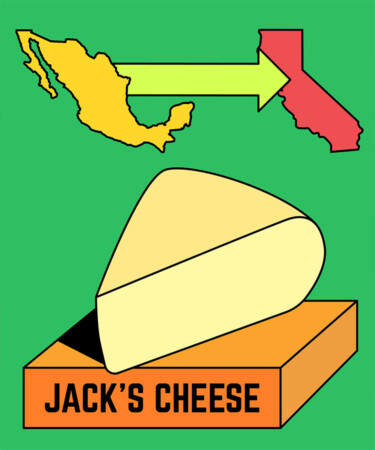This article is part of our Cocktail Chatter series, where we dive into the wild, weird, and wondrous corners of history to share over a cocktail and impress your friends.
When European settlers began trickling into the American colonies, they brought their food and drink traditions with them. From winemaking to distilling to cheesemaking, techniques and products we may now consider to be a part of American gastronomy usually trace back to other cultures and continents. One prime example is Monterey Jack cheese. Though often listed as an American or Californian product, it’s about as American as tacos and guacamole. Upon cheesemaking’s arrival in the States, there were some bold moves by bold businessmen to rewrite the narrative of a certain Italian cheese.
The Wild West
The Roman Empire collapsed in 476 A.D., and much of the world’s knowledge on cheesemaking vanished along with it, though Christian monasteries held on to some Roman techniques for wine and cheese production that endured through the fall. So when Franciscan monks and missionaries eventually traveled abroad, they brought their religion and their knowledge of cheese and winemaking to Majorca, Spain, and eventually Mexico.
Back in 1769, Spanish Franciscan priest Junipero Serra traveled to northern Mexico and founded the first California Catholic mission near present-day San Diego. The following year, another mission popped up at Monterey Bay. With these missions came Spanish foods, including olives, grapes, cattle, and queso blanco país, also known as country white cheese. Roughly 80 years later, California became a U.S. state, and settlers came flooding into the new state in search of gold, land, and good fortune.
When Mexico sold the state, the U.S. agreed to uphold Mexico’s rancho system in which plots of land were given to retired soldiers and Mexican peoples trying to move north. However, the U.S. government planted a few loopholes in the treaty that allowed it to take advantage of Mexican farmers, requesting long-lost paperwork and attendance at inconvenient, faraway court hearings. These combined factors allowed many people to take over previously Mexican-owned farms, including one less-than-honorable businessman in particular. .
When Monterey Jack Got Jacked
A man named David Jack moved from New York to California in 1849, allegedly with a suitcase full of revolvers to sell on the black market. Upon his arrival, he changed his last name to “Jacks,” and by 1857, he had settled in Monterey and made friends with attorney Delos R. Ashley. The town of Monterey hired Ashley to legitimize its land claims under the eyes of the U.S. Land Claims Commission. After winning the case, Ashley demanded about $1,000 in attorney fees, which the town couldn’t afford to pay at the time. To settle up, the town agreed to auction off the very lands Ashley helped legitimize to pay off the fees. On Feb. 9, 1859, a sketchy, last-minute auction was called, and the only two bidders in attendance were Ashley himself and David Jacks. Almost all of Monterey was sold to the pair for an equally sketchy $1,000.02. Essentially, the two men scammed the town of Monterey out of its own land.
By most accounts, Jacks was, simply put, a jerk. There was one rumored instance when the city of Monterey borrowed money from Jacks to purchase a new fire engine for $10,000. When city officials got the loan, Jacks took out a mortgage on the city. On the same day the mortgage was due, Jacks hosted a bear-baiting and free whiskey event, so all the town officials got drunk and subsequently forgot about the payment. Jacks had successfully bamboozled his way to acquiring the town, but the townspeople apparently reacted with such frustration that he forfeited the deal and gave the town back.
Still, Jacks proceeded to squeeze as much profit out of his nearly 60,000 acres of land as possible. He upped residents’ taxes astronomically and foreclosed on properties when renters couldn’t afford to pay. He would even leave notices in English on the homes of Spanish-speaking farmers to deliberately confuse them. With a bad attitude and no qualms about corruption, Jacks made the land his own empire, establishing vineyards, 14 cattle ranches, and a handful of dairies. In said dairies, workers continued to produce queso blanco país. But of course, Jacks wanted to claim ownership of that, too, so he began selling it around the Monterey area under the self-indulgent moniker “Jack’s Cheese.” Despite its cringe-y branding, Californians couldn’t get enough of the stuff, and as demand increased, people across the state began requesting “Monterey Jack’s cheese.”
Jacks died in 1909, and the cheese was officially dubbed “Monterey Jack cheese” by the Food and Drug Administration in 1955. And while Jacks may have found a way to immortalize himself from beyond the grave, his three daughters allegedly left most of his estate to charities, schools, and the restoration of historic buildings around Monterey, according to accountant Norman C. Earl.
Jack’s Cheese or Jack Cheese?
There are, though, some conflicting theories that say Jacks wasn’t actually the first to sell jack cheese in the state. The most feasible story that contests Jacks’ claim to the cheese is that Domingo Pedrazzi of Carmel Valley was making cheese that required a device called a “housejack” for applying pressure to his product. The resulting cheese became known as “Pedrazzi’s jack cheese,” though it was later marketed as “Del Monte cheese.” While that would make for a less controversial origin story, most sources point to the more devious Jacks and his sketchy business practices.
Since the ‘50s, Monterey Jack cheese has made possible the invention of Colby Jack, Pepper Jack, Cheddar Jack, and other beloved hybrids. But the next time you go to make a 3 a.m. cheese quesadilla, raise a wedge in honor of queso blanco país — the real Monterey Jack.
